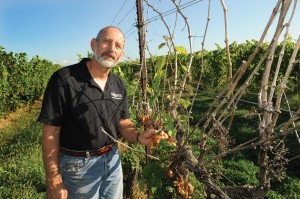
New OARDC research will benefit businesses like Columbus Castings, shown here, say OARDC’s Nicholas Basta, left, and the Ohio Cast Metals Association’s Russ Murray, right. (Photo: Ken Chamberlain, CFAES.)
What to do with 10 million tons of sand every year that would otherwise go in a landfill? Use it to grow plants and industry.
Ohio Agricultural Research and Development Center scientists Nicholas Basta and Elizabeth Dayton worked in tandem with the U.S. Department of Agriculture to do detailed testing of spent foundry sand for such toxins as heavy metals. The sand is a byproduct of the metal casting industry.
Their findings fed into a risk assessment by the U.S. Environmental Protection Agency. The assessment determined that spent foundry sand, when put back to use in some soil applications, is safe for people’s health and the environment. The finding applies only to silica sand from aluminum, iron and steel foundries.
The work has opened new business doors. Ohio’s green industry now can manufacture and market new soil mixes using the sand. And the state’s many metal casting foundries can reduce their landfilling costs, save money and stay competitive.
“Based on this research, Ohio EPA is developing new rules for beneficially reusing spent foundry sand,” said Russ Murray, executive director of the Ohio Cast Metals Association. “We’re confident these rules will provide opportunities for Ohio foundries to significantly reduce their disposal costs for the sand. This should make these foundries more competitive.”
Essentials
- Ohio is the No. 1 metal casting state in the nation. Its 200-plus foundries provide 22,000 jobs and produce metal castings for products such as cars, trucks, tractors, turbines, aircraft and appliances.
- Reusing 10 percent of the 10 million tons of spent foundry sand sent to landfills every year can save U.S. foundries about $40 million annually. That’s based on an average disposal cost of $40 a ton.
- The potential savings for Ohio and U.S. foundries will be a leg up in an increasingly competitive international market.
- Reusing spent foundry sand will also create new businesses and jobs. These businesses and jobs will be based on using spent foundry sand to make new soil blends and soil substitutes.
Read more about this research here.

